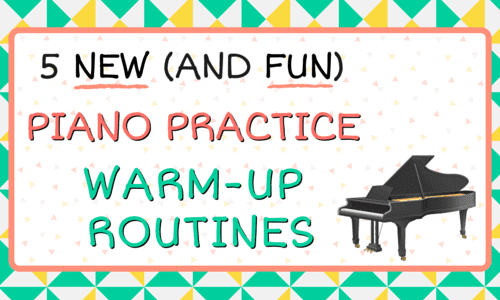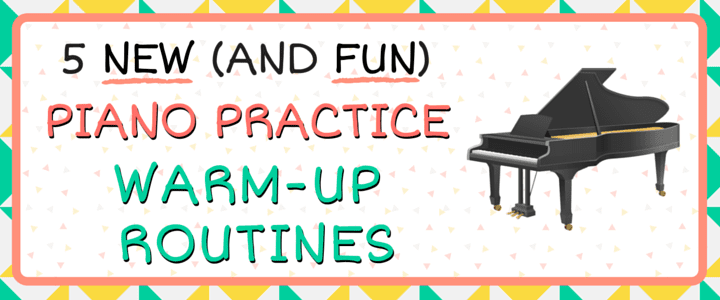Are you in search of some new piano practice warm-up routines? Below, piano teacher Liz T. shares some fun piano practice warm-ups you can try before your next practice…
You wouldn’t go for an hour-long run before properly warming up. So, why wouldn’t you warm-up before an hour-long piano practice session or lesson?
No matter what instrument you play, it’s extremely important that you go through a series of warm-ups before you start playing.
In this post, we will discuss why you should take the time to warm-up before your piano lesson, as well as some fun warm-up exercises you can try.
Why is it Important to Warm-Up Before Piano Practice?
-
Prevents harmful injuries
Just like an athlete stretches before practice, pianists must also stretch their fingers, wrists, hands, arms, shoulders, and elbows before playing extensively.
If you forget to warm-up your muscles, you could end up with a painful injury (i.e. carpal tunnel, tendinitis, arthritis, etc) that could take you out of the game for weeks, or worse, months!
-
Repetitive muscle memory
Your fingers, wrists, and hands must be accustomed to the different motions you use while playing. If you haven’t practiced the piano for some time, the motions may feel very strange and awkward.
Warming up will help get your muscles accustomed to playing fast and slow tempos, long and short phrases, and challenging melodic patterns, or chord changes/inversions.
-
Improves ear training and harmony
As a pianist, you must be aware of music theory and be able to analyze what you’re playing. Warming up with scales and chord progressions are a great way to start training your ear.
The more you warm-up with different scales and chords on a regular basis, the better your knowledge of music theory will become.
5 Fun Piano Practice Warm-Up Exercises
1. Sing along with intervals
When warming up with intervals, try singing along to a familiar song. From Ascending to Descending, there are many songs that you may already know.
Singing these songs while you practice and recognizing intervals on the keys will help. Below are some examples:
2. Chromatics
With a partner, practice the Chromatic scale, ascending and descending in different keys. While your partner closes his or her eyes, play the scale, skipping a note of your choosing.
Your partner will have to guess which interval/note you were playing. Do this multiple times, skipping different notes. Then switch positions and have your partner challenge you.
3. Major/Minor
With a friend or your piano teacher, create your own bingo/roll the dice game. On the board game, label pictures of the major and minor scales and chords without it’s scale name.
You will then have to recognize which scale or chord it is, and play it on the piano. Challenge yourself with both major and minor scales, and then reward yourself with something fun like stickers, candy or trading cards!
4. Rhythmic
Create your own rhythms first by clapping, and then playing them on a single note on the piano. For instance, “two eight notes, then a whole night, then a four sixteenth notes.”
Then grab yourself some staff paper, and divide bar lines, and transcribe what comes to your ear. Once you’ve created a short 8 bar rhythm, play the whole rhythm. Then add a specific melody, and you’ve got yourself an original song!
5. Favorite song
Pick a song you know well, perhaps a song that you’ve performed before. Some of my favorites in the past have included, Fur Elise, Prelude to the Well-Tempered Clavichord, The Entertainer, and The Piano Man.
Use this song as your mantra or meditation before and after your piano practice. Analyze the song by envisioning the chords, inversions, voicings, melodic and rhythmic patterns, scales, and modes.
Pay attention to the dynamics and tempo markings in the form of the song. Once you have analyzed your favorite piece, challenge yourself to memorize the piece measure by measure.
Then once you feel comfortable, play the entire song each practice session by memory. This will not only help you keep up with your theory, but also with your performance skills.
Now It’s Your Turn!
I hope you will find these piano practice warm-up exercises fun and useful! Next time you have a few minutes before your practice session, try one of these exercises.
 Post Author: Liz T.
Post Author: Liz T.Liz T. teaches singing, acting, and music lessons online. She is a graduate of the Berklee College of Music with a B.M in Vocal performance and currently performs/teaches all styles of music including Musical Theater, Classical, Jazz, Rock, Pop, R&B, and Country. Learn more about Liz here!
Photo by Tulane Public Relations
Suzy S.


